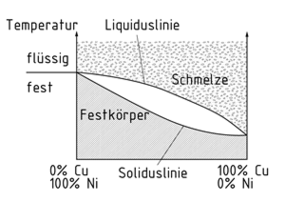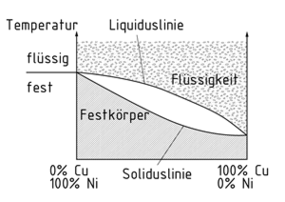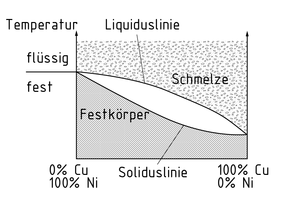
Wählen Sie eine
oder mehrere Sprachen aus
0,1,0
- Deutsch
- Englisch
- Chinesisch
- Spanisch
Legierung

Als Legierung werden metallische Werkstoffe aus mindestens zwei Werkstoffen bezeichnet, die eine Metallbindung eingehen. Je nach Zahl der Komponenten ergeben sich Zwei-, Drei-, Vier- oder Mehrstofflegierungen. Durch Legierung können die Eigenschaften von Metallen verändert und bestimmte Eigenschaftsprofile erreicht werden. Bestimmt werden diese durch die gegenseitige Aufnahmefähigkeit der Legierungskomponenten (Löslichkeit) und die Art der gebildeten Kristalle (Substitutionsmischkristalle, Einlagerungsmischkristalle, Gemische aus Misch- und Primärkristallen, intermetallische Phasen). Die Art der Kristallisation wird beeinflusst von
- der Art und Anzahl der Legierungselemente,
- ihren Masseanteilen und
- der Temperatur.
Die meisten Legierungen erstarren in einem Haltebereich, der zwischen der Solidustemperatur der einzelnen Komponenten liegt. Eine Ausnahme bilden die eutektischen Legierungen mit festem Schmelzpunkt. Aus einer Schmelze kristallisieren zunächst die Metalle mit der höchsten Solidustemperatur aus. Bei weiterer Abkühlung ändern die Mischkristalle ihre Zusammensetzung hin zur Komponente mit der niedrigeren Solidustemperatur. Gleichzeitig verändern die Kristalle bei langsamer Abkühlung kontinuierlich ihre Zusammensetzung durch Diffusion. Je schneller abgekühlt wird, desto feinkörniger ist das Gefüge. Die Vorgänge bei der Herstellung einer Legierung werden in Zustandsschaubildern (Phasendiagrammen) dargestellt.
Legierungen werden gekennzeichnet, indem zunächst ihr Hauptbestandteil und dann die merkmalgebenden Komponenten genannt werden. Unterschieden werden Eisen- und Nichteisen-Legierungen. Pseudolegierungen sind versinterte Metallpulver.
Alloy

An alloy is a metallic Material comprising at least two constituents that form a metallic bond. Depending on the number of constituents, this produces binary, ternary, quaternary or complex alloys. Alloying changes the properties of Metals and gives them a specific profile of properties that is determined by the mutual absorbability of the alloying constituents (solubility) and the type of crystals formed (substitutional solid solutions, interstitial solid solutions, combinations of mixed and primary crystals, intermetallic phases). The type of crystallisation is influenced by
- the type and number of alloying elements,
- their mass fractions and
- the temperature.
Most alloys solidify in a mushy zone between the solidus temperatures of the individual constituents. Eutectic alloys, which have a fixed melting point, are one exception. The metals with the highest solidus temperature crystallise from a melt first. As cooling continues, the composition of the mixed crystals becomes more like the constituent with the lower solidus temperature. As the crystals slowly cool, their composition also continuously changes as a result of diffusion. The faster the cooling, the more fine-grained the (micro)structure. The steps involved in making an alloy are depicted in phase diagrams.
Alloys are identified by stating their main component followed by their characterising constituents. A distinction is made between ferrous and non-ferrous alloys. Pseudoalloys are sintered metal powders.
合金

合金是指至少包含两种成分的金属材料,成分之间以金属键连接。根据成分的数量,分为二元、三元、四元或多元合金。合金化改变了金属的性能描述,合金成分的共同吸收性(溶解度)和形成的晶体类型(置换固溶体, 间隙固溶体,混晶和初晶结合体,金属间相)确定了合金的性能描述。结晶的类型受到以下因素的影响:
合金元素的类型、数量,
合金元素的质量分数
气温。
大多数合金在各成分的固相温度间的糊状区内固化。共晶合金是一个例外,它具有一个固定的熔点。具有最高固相温度的金属在熔体中首先结晶。继续冷却时,混合晶体合成物的性质更类似固相温度较低的成分。由于晶体缓慢冷却,其合成物也由于扩散而不断变化。降温越快,晶粒的(微观)结构越细。合金的制造步骤描述见相图。
合金根据其主要合成物和特征成分而定义。可分为黑色金属合金和有色金属合金。假合金是由金属粉末烧结而成的。
合金的相图
Aleación

Una aleación es un material que consta de al menos dos constituyentes que forman un enlace metálico. Dependiendo del número de constituyentes, esto produce aleaciones binarias, ternarias, cuaternarias o complejas. La aleación cambia las propiedades de los metales y les da específicas que se determinan mediante la capacidad de absorción mutua de los constituyentes de la aleación (solubilidad) y el tipo de cristales formados (soluciones sólidas de sustitución, soluciones sólidas intersticiales, combinaciones de cristales primarios y mixtos, fases intermetalicas). El tipo de cristalización es influenciado por:
El tipo y número de elementos de aleación,
Sus fracciones de masa y
La temperatura.
La mayoría de las aleaciones se solidifican en una zona pastosa entre las temperaturas de solidificación de los constituyentes individuales. Las , las cuales tienen un punto de fusión fijo, son una excepción. Los metales con las temperatura de solidificación más altas se cristalizan en una fundición primero. Al continuar el enfriamiento, la composición de los cristales mixtos se asemeja más al constituyente con la menor temperatura de solidificación. Al enfriarse lentamente los cristales, su composición también cambia continuamente como resultado de la difusión. Entre más rápido sea el enfriado, más fina será la veta de la (micro) estructura. Los pasos requeridos para hacer una aleación se muestran en los diagramas de fase.
Las aleaciones son identificadas al mencionar su componente principal seguido de sus constituyentes característicos. Se debe distinguir entre las aleaciones ferrosas y las no ferrosas. Las seudoaleaciones son polvos de metal sinterizado.
Diagrama de fases de una aleación
